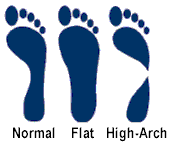Inside Insoles

Can off-the-shelf insoles correct your running gait?
This article appeared in our August 2010 issue.
Amisaligned foot strike is often the culprit behind metatarsal pain, plantar fasciitis, iliotibial (IT) band syndrome, shin splints, piriformis syndrome and various types of foot, knee and back pain. The prescription for such misalignments, resulting from overpronation, supination and high or flat arches, is often a custom-made orthotic.
But having an orthotic made can take weeks (plus break-in time), and cost between $350 and $475. However, an alternative lies in the ever-expanding selection of high-quality—and low-cost—off-the-shelf insoles.
Off-the-shelf insoles are available in three main types: cushioning (which may include metatarsal pads or pockets of shock-absorbing gel or foam), stability (with medium-stiffness support features) and motion-control (with a rigid arch support and/or deep heel pocket).
Try before you buy, though. At the store, slip the insole inside your running shoes and walk around, paying attention to where you feel excess pressure that could indicate an improper fit. Orthotist Charlie Johnson, former head biomechanist at Carmichael Training System’s Performance Center in Aspen, says to choose an insole that still allows your arch to flex when weighted.
“The arch is designed to work like a leaf spring,” he says. “The foot flattens during absorption phase, then the plantar fascia elongates and loads like a bowstring, which helps in propulsion during toe-off.”
However, overpronators should be aware that merely placing a cushioning wedge under the arch will not prevent it from over-flattening. “Pronation-control points are at the rear foot and forefoot, so a deep heel cup is going to do more to limit excessive lateral movement,” says Johnson.
Foot Types | To select the right insole, identify your foot type
1 Wet the sole of your foot 2 Step on a paper shopping bag 3 Match shape to one of the below.
Normal arch or neutral footstrike Only about a quarter of the population has a truly neutral footstrike, in which the arch flexes sufficiently to absorb impact without over flattening. If this is you, select a flexible, cushioned insole to use with a neutral trail-running shoe.
Flat feet or severe overpronators Upon contact with the ground, the medial side of the foot rolls excessively inward and the arch flattens, which can lead to knee, hip and back issues. Select a “corrective” insole with arch support and deep heel cup to limit overpronation. Beware using such an insole in a motion-control shoe (with medial posting), which may overcorrect your gait and cause injury.
High arch or supinator High arches are typically rigid and do not flex enough to absorb the impact of running. A shock-absorbing insole inside a neutral, cushioned running shoe will help prevent lower-body injuries resulting from impact stress.
photo courtesy of http://collegelifestyles.org/